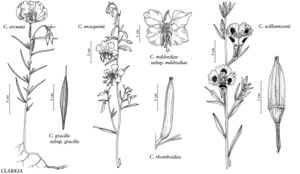Clarkia williamsonii
Madroño 12: 34. 1953.
Stems erect, to 100 cm, puberulent. Leaves: petiole 0–10 mm; blade linear to narrowly lanceolate, 2–7 cm. Inflorescences open racemes, axis straight; buds erect, mucronate. Flowers: floral-tube 7–13 mm; sepals reflexed individually or in pairs, tips distinct in bud; corolla bowl-shaped, petals usually lavender, white near middle with purple spot distally, rarely uniformly wine-red, 10–30 mm; stamens 8, subequal; ovary 8-grooved, shorter than adjacent internode; stigma usually exserted beyond anthers. Capsules 10–30 mm. Seeds brown or gray, 1–1.5 mm, scaly, crest 0.1 mm. 2n = 18.
Phenology: Flowering Apr–Sep.
Habitat: Foothill woodlands, yellow-pine forests.
Elevation: 400–2000 m.
Discussion
Clarkia williamsonii occurs widely along the western slope of the Sierra Nevada from Nevada to Kern counties, and the Tehachapi Mountains barely to Los Angeles and Santa Barbara counties (one collection each). There are unverified reports from Riverside and Shasta counties.
Clarkia williamsonii is similar to C. speciosa and some populations of the hexaploid C. purpurea but can be distinguished from the former by petal color pattern and from both by having sepals that have distinctly free tips in bud, a trait most obvious in pressed specimens when the tips tend to spread apart.
Selected References
None.
